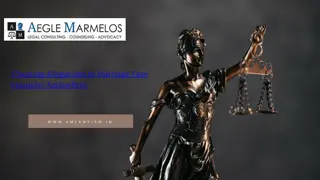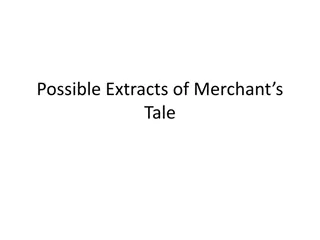The Wife of Bath's Prologue: An Analysis of Marriage and Authority
The Wife of Bath, an authority on marriage due to her multiple experiences, challenges traditional views on marriage using biblical references and personal interpretations. She explores the idea of multiplying and the ambiguity surrounding the number of allowed marriages, questioning societal norms and religious teachings.
Uploaded on Sep 07, 2024 | 1 Views
Download Presentation

Please find below an Image/Link to download the presentation.
The content on the website is provided AS IS for your information and personal use only. It may not be sold, licensed, or shared on other websites without obtaining consent from the author. Download presentation by click this link. If you encounter any issues during the download, it is possible that the publisher has removed the file from their server.
E N D
Presentation Transcript
Geoffrey Chaucer: The Wife of Bath s Prologue Dr. Ankit Trivedi Assistant Professor Chhtrapati SahuJi Maharaj, Kanpur
Content Author Details Text Summary Explanation/Analysis Literary Devices Conclusion
Poet: Geoffrey Chaucer English poet Geoffrey Chaucer was an English poet, author, and civil servant best known for The Canterbury Tales. He has been called the "father of English literature", ... Notable works: The Canterbury Tales Language: Middle English Period: Middle English literature Literary movement: Precursor to the English R... The Canterbury Tales The Book of the Duchess A Treatise on the Astrolabe
Text: The Wife of Baths Prologue Experience, though no authority Were in this world, were good enough for me, To speak of woe that is in all marriage; For, masters, since I was twelve years of age, Thanks be to God Who is for aye alive, Of husbands at church door have I had five; For men so many times have wedded me; And all were worthy men in their degree. But someone told me not so long ago That since Our Lord, save once, would never go To wedding (that at Cana in Galilee), Thus, by this same example, showed He me I never should have married more than once. Lo and behold! What sharp words, for the nonce, Beside a well Lord Jesus, God and man, Spoke in reproving the Samaritan: 'For thou hast had five husbands,' thus said He, 'And he whom thou hast now to be with thee Is not thine husband.' Thus He said that day, But what He meant thereby I cannot say; And I would ask now why that same fifth man Was not husband to the Samaritan? How many might she have, then, in marriage? For I have never heard, in all my age, Clear exposition of this number shown, Though men may guess and argue up and down. But well I know and say, and do not lie, God bade us to increase and multiply; That worthy text can I well understand. And well I know He said, too, my husband Should father leave, and mother, and cleave to me; But no specific number mentioned He, Whether of bigamy or octogamy; Why should men speak of it reproachfully?
Summary: The Wife of Baths Prologue The Wife of Bath begins the Prologue to her tale by establishing herself as an authority on marriage, due to her extensive personal experience with the institution. Since her first marriage at the tender age of twelve, she has had five husbands. She says that many people have criticized her for her numerous marriages, most of them on the basis that Christ went only once to a wedding, at Cana in Galilee. The Wife of Bath has her own views of Scripture and God s plan. She says that men can only guess and interpret what Jesus meant when he told a Samaritan woman that her fifth husband was not her husband. With or without this bit of Scripture, no man has ever been able to give her an exact reply when she asks to know how many husbands a woman may have in her lifetime. God bade us to wax fruitful and multiply, she says, and that is the text that she wholeheartedly endorses. After all, great Old Testament figures, like Abraham, Jacob, and Solomon, enjoyed multiple wives at once. She admits that many great Fathers of the Church have proclaimed the importance of virginity, such as the Apostle Paul. But, she reasons, even if virginity is important, someone must be procreating so that virgins can be created. Leave virginity to the perfect, she says, and let the rest of us use our gifts as best we may and her gift, doubtless, is her sexual power. She uses this power as an instrument to control her husbands. At this point, the Pardoner interrupts. He is planning to marry soon and worries that his wife will control his body, as the Wife of Bath describes. The Wife of Bath tells him to have patience and to listen to the whole tale to see if it reveals the truth about marriage. Of her five husbands, three have been good and two have been bad. The first three were good, she admits, mostly because they were rich, old, and submissive. She laughs to recall the torments that she put these men through and recounts a typical conversation that she had with her older husbands. She would accuse her husband of having an affair, launching into a tirade in which she would charge him with a bewildering array of accusations. If one of her husbands got drunk, she would claim he said that every wife is out to destroy her husband. He would then feel guilty and give her what she wanted. All of this, the Wife of Bath tells the rest of the pilgrims, was a pack of lies her husbands never held these opinions, but she made these claims to give them grief. Worse, she would tease her husbands in bed, refusing to give them full satisfaction until they promised her money. She admits proudly to using her verbal and sexual power to bring her husbands to total submission.
Analysis In her lengthy Prologue, the Wife of Bath recites her autobiography, announcing in her very first word that experience will be her guide. Yet, despite her claim that experience is her sole authority, the Wife of Bath apparently feels the need to establish her authority in a more scholarly way. She imitates the ways of churchmen and scholars by backing up her claims with quotations from Scripture and works of antiquity. The Wife carelessly flings around references as textual evidence to buttress her argument, most of which don t really correspond to her points. Her reference to Ptolemy s Almageste, for instance, is completely erroneous the phrase she attributes to that book appears nowhere in the work. Although her many errors display her lack of real scholarship, they also convey Chaucer s mockery of the churchmen present, who often misused Scripture to justify their devious actions. The Ones Who Walk Away from Omelas The text of the Wife of Bath s Prologue is based in the medieval genre of allegorical confession. In a morality play, a personified vice such as Gluttony or Lust confesses his or her sins to the audience in a life story. The Wife is exactly what the medieval Church saw as a wicked woman, and she is proud of it from the very beginning, her speech has undertones of conflict with her patriarchal society. Because the statements that the Wife of Bath attributes to her husbands were taken from a number of satires published in Chaucer s time, which half-comically portrayed women as unfaithful, superficial, evil creatures, always out to undermine their husbands, feminist critics have often tried to portray the Wife as one of the first feminist characters in literature. This interpretation is weakened by the fact that the Wife of Bath herself conforms to a number of these misogynist and misogamist (antimarriage) stereotypes. For example, she describes herself as sexually voracious but at the same time as someone who only has sex to get money, thereby combining two contradictory stereotypes. She also describes how she dominated her husband, playing on a fear that was common to men, as the Pardoner s nervous interjection reveals. Despite their contradictions, all of these ideas about women were used by men to support a hierarchy in which men dominated women.
Literary Devices Used Throughout The Wife of Bath s Prologue , Chaucer uses imagery to enhance our understanding of the Wife s character and principles. Chaucer makes use of simple yet powerful metaphors such as fire and nature to augment our understanding of the Wife s personality. However, some of the more fundamental images throughout the poem animals and trade, for example help portray the Wife s key arguments and ideas and are used to aid social commentary throughout the text. Many of these images would have been particularly pertinent in the medieval context in which The Canterbury Tales were written and would have therefore been useful in enhancing the reader/ listener s understanding of the overarching themes of the prologue.























